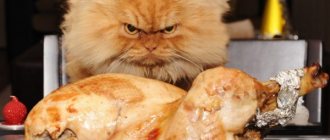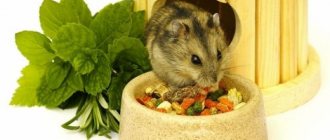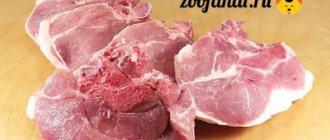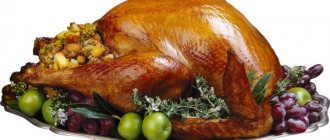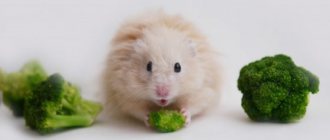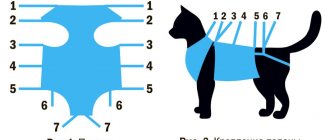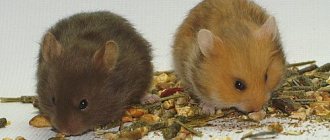Vegetables in a cat's diet
Almost all commercial cat foods contain vegetable additives. No wonder. Digestion is a complex process and depends on many factors.
Cats do not show much interest in raw vegetables, although there are exceptions to the rule. Normal nutrition, as we know, consists of three main components :
This is an energy component for the body, but the cat’s digestion requires additional ingredients contained in plant foods. There are few of them, but they are as necessary for a pet as meat. You can give them; cats will benefit from vegetables if done correctly.
Fiber, which the animal's body extracts from vegetables, plays an important role. This is why it is necessary to include raw or boiled vegetables in your cat’s diet. It has no nutritional value, but is involved in the digestion of food and normalizes the functioning of the digestive tract.
A cat's stomach cannot digest fiber. It is excreted from the body in its original form, but at the same time helps push the food coma through the intestines, adsorbs harmful substances and forms normal feces. Simply put, it facilitates the process of cleansing the intestines. Vitamins, minerals and microelements contained in vegetables are not paramount. The role of fiber is much more important.
A vegetable diet is especially useful for well-fed cats whose metabolism is impaired. It can include up to 20% of vegetables from the total food. Vegetables fill the stomach, creating a feeling of fullness, while the total number of calories is reduced and the cat loses weight. It is very important not to upset the normal balance. Too much vegetables can cause digestive upset. Just 3% vegetables is enough for a healthy cat. This amount is considered optimal.
The cat herself will help you decide which vegetables to give your cat. It is impossible to force her to “gnaw” plant food.
Vegetable menu
You cannot feed your pet all vegetables in a row. It is necessary to understand which vegetables are good for cats and which should not be given.
The taste buds on a cat's tongue perfectly distinguish between the bitter and sour tastes of food, so it will not be possible to force it to eat radishes or radishes. The animal prefers vegetables with a neutral taste, which easily absorb the smell of meat.
There are vegetables that are more harmful than beneficial, for example, white cabbage, which quickly begins to ferment in the intestines and causes flatulence.
The list of vegetables that can be safely given to cats is quite long. It includes :
- Zucchini. Can be given both raw and boiled.
- Onion. Added to food after heat treatment.
- Beet. Boil and finely chop, mixing with meat. Give in small quantities so as not to provoke diarrhea.
- Broccoli and cauliflower. Heat treatment required.
- Carrot. When fresh, grate and mix with food. You can alternate boiled and raw.
- Cucumber. They are given raw.
- Spinach. In raw form.
If desired, the list can be expanded. You can give almost all vegetables if your pet eats them with pleasure and without harmful consequences for the body. It is better to avoid potatoes. It contains a large amount of carbohydrates, which can have a harmful effect on metabolism.
There is no need to add vegetables to dry food; it contains a sufficient amount of fiber.
What's best for cats?
Based on observations of cats, it was found that almost all of them happily accept food containing potatoes, carrots or pumpkin. Only adult animals are recommended to add vegetable components to their food. The motility of their intestines depends on what vegetables cats eat, and if you add too much, you can get consequences in the form of gastrointestinal upset.
It is known which vegetables can be fed to cats, and which ones are definitely not? There are some that pose a danger and are toxic to pets - avocados, onions and garlic. These plants cannot be given in any form, and the cats themselves will not eat them.
By adding vegetables to dry food, you can better balance the diet and feed your cat more nutritiously. Additional minerals and vitamins will improve metabolism, add energy to the animal, and help overcome vitamin deficiency. Many branded foods already contain vegetable ingredients, and if your pet requires vegetables, he may need a higher-class food with more nutrients contained.
The cat eats too many vegetables
Some cat owners are faced with the fact that their cat constantly chews raw vegetables. This strange addiction is partly explained by the following reasons :
- Taste preferences. Perhaps the cat instinctively feels the need for certain elements contained in vegetables or she simply likes the taste.
- Problems in the oral cavity. Some experts believe that in this way the cat cleanses its teeth and massages its gums. The owner should pay attention to the presence of tartar.
This behavior is not typical for a predator. Of course, you should give your cat raw vegetables, but their quantity should be limited. Uncontrolled consumption of vegetables threatens serious digestive disorders, so an “inadequate” pet must be shown to a veterinarian. It may be a serious illness.
If it turns out that the cat is completely healthy and his love for vegetables does not threaten him in any way, then there is nothing to worry about. Many cats are guided by instinct, which tells them what kind of food is needed at the moment. It is possible that eating raw vegetables is a temporary phenomenon.
Which food to choose?
Manufacturers now offer a huge selection of all kinds of animal feed of different quality and price categories. So where should you choose, what food is best for cats?
You should immediately throw away human food from the table, porridge, milk, fish and the like. This food, apart from being harmful to the cat's health, will do nothing for your pet.
Many industrial feeds, even despite their stated balance and ease of feeding, contain mainly plant proteins. Therefore, they are not able to give pets everything they need for normal functioning and have a bad effect on the kidneys, teeth, fur, and their use leads to irreversible negative consequences in the cat’s body.
Wet food is an excellent option for complete cat nutrition, but it has significant disadvantages - it is quite expensive and has a short shelf life.
Such food will not be able to protect cats from the formation of tartar, which should also be taken into account when purchasing such food. Therefore, to maintain the activity, health and longevity of your pet, choose raw natural diets.
One of the best daily food options for cats is natural, raw food.
- This type of food is best suited for your pets, as it optimally combines all the ingredients necessary for daily feeding of cats.
- This food is not subjected to heat treatment, which means that all useful substances are preserved in it.
- Raw meat, which forms the basis of this natural food, is perfectly digestible by animals and normalizes their digestion, and also contains the necessary amount of moisture and, in general, has a very beneficial effect on the health and appearance of animals.
The undoubted advantage of such raw foods is that they are hypoallergenic and are excellent for spayed/sterilized cats.
Read more about Superpet on another site.
What vegetables can you give cats?
Unlike dogs, cats are more picky eaters. Animal protein is the only protein that satisfies the nutritional needs of an animal. Therefore, vegetables do not have any special nutritional value; in addition, meowing pets do not have the enzymes necessary to digest plant foods, which means they are poorly absorbed.
However, a small amount of vegetables in a pet’s diet has certain benefits for the body. For example, it is useful to feed them to an obese cat. Leafy vegetables help remove toxins from the intestines and hairballs.
It is not for nothing that they are included in dry food. Even in dried form, included in the feed in the required quantity, they provide some benefits. Especially if used on an ongoing basis.
Vegetables for kittens: pros and cons of natural nutrition
In order for an animal to be healthy and live a long time, its diet must be balanced and contain the optimal amount of substances necessary for the body.
Meals need to be prepared correctly. This requires some skill and time. Even a British kitten or a purebred kitten can eat vegetables. But to introduce them into the diet, you will have to turn to zoology and study the feline body. For example, they have difficulty digesting plants, and some organisms are unable to convert certain substances.
But plants can also benefit:
- they provide fiber, without which normal intestinal function is impossible;
- To stabilize the digestive system, you will need probiotics and adhesives;
- for the brain to function and for the kitten to have the strength to play, it must consume glucose;
- Animals get the fluid they need from vegetables.
Therefore, knowing what vegetables a kitten can eat at 2 months old, you can create a suitable menu for it, taking into account the benefits and harms of certain foods.
Vegetables are safe for cats
The basic rules for safely feeding cats vegetables come down to just three points. First, vegetables should make up no more than 10% of the daily intake (about 2-3 teaspoons, depending on the weight and size of the animal). Secondly, they are given exclusively boiled or steamed, since raw ones are difficult for the animal to absorb, they are more difficult to digest and can get stuck in the throat, causing suffocation. Thirdly, vegetables are cut into small pieces that are convenient for the animal to eat, or crushed into puree and mixed with the main food (except dairy products) or given separately.
Only a small list of vegetables is considered safe for cat health. In addition to leafy vegetables (lettuce, the darker the leaf, the better), which are effective in removing hairballs from your pet’s stomach and intestines, you can feed your pet:
- Carrots that many pets love.
- Zucchini is rich in magnesium, manganese and potassium.
- Broccoli contains antioxidants.
- Asparagus, which is a source of fiber and vitamins.
- Green beans, which are an excellent source of fiber and are enjoyed by many cats.
- Cucumbers that do not need to be boiled, but are better served fresh. Some pets adore them, perhaps because they quench their thirst.
- Celery, rich in vitamins and microelements.
- Melon, given in small quantities, peeled and seeded.
It is known that cats cannot taste sweets. But some meowing pets are a fan of melon and enjoy eating watermelon, peaches, and blueberries.
It is better to avoid other vegetables and fruits and not try to include them in the diet of a meowing pet. Because to varying degrees they are either difficult to digest or toxic to cats. Under no circumstances should you give onions, garlic, grapes, raisins, or avocados - they are extremely toxic to animals. They can cause simple digestive upset or lead to severe poisoning, depending on the dosage. For example, raisins can cause sudden kidney failure, and onions and garlic lead to the development of anemia.
It should be remembered that you need to introduce vegetables into your cat’s diet gradually, separately and in small quantities. It is important to evaluate the body’s reaction to a new product, as well as the pet’s desire to eat a specific vegetable. If the pet refuses, then there is no need to insist. If after consumption there is an upset stomach (diarrhea, bloating), then there is no need to give it to the animal anymore.
You should take care of pets that tend to chew indoor plants. They may refuse vegetables, but they will not refuse grass grown specifically for them, for example, sprouted oats. The herb helps cleanse the stomach and intestines and is rich in vitamins and microelements.
In what form is it better to give vegetables?
Cats can and should eat vegetables. Wild members of the family first eat the stomach of the herbivorous victim along with its contents - grass and plant fruits.
The “dish” treated with gastric juice and half-digested serves as an additional source of enzymes. This helps the predator digest heavy meat food.
Boiled or steamed vegetables are better processed by the domestic cat's digestive system. It is preferable to boil parsley, spinach, celery, dill and chop thoroughly. The same should be done with tough, fibrous vegetables.
To avoid endangering your cat, vegetables should be introduced into the diet gradually. In the first days of such complementary feeding, the additives are ground and mixed with the main food. Subsequently, the plant food is finely chopped.
Kittens can introduce vegetables into their diet from the age of three months. After adding a new type of food, you should monitor the body's reaction. If there is no stool disorder, vomiting, or allergic reaction, you can diversify the menu.
In between meals, it is permissible to give the kitten some fresh carrots or cucumber slices. By gnawing on the elastic vegetable pulp, animals refresh the oral cavity and clean their teeth.
What vegetables can you give your cat?
New cat owners often ask questions related to natural nutrition. They are interested in the quantity and types of products allowed for feeding cats and kittens, methods of their preparation, and compatibility in the diet. Do cats, who are carnivores by nature, need vegetables? Which types should be preferred?
nie? Let's find out in detail.
Energy needs of a cat
Before looking for an answer to the question of what to feed your cat, you need to find out the quality characteristics of the food. The diet should contain a certain set of useful elements that replenish energy expenditure and maintain skeletal muscles in good shape. A sexually mature individual outside the period of gestation and lactation requires about 75 kcal per kilogram of body weight.
Feeding a cat requires special rules
The list includes the following elements (calculation is carried out per 1 kg of body weight):
- arginine - 0.38 g;
- protein - 6.3 g;
- valine - 0.34 g;
- histidine - 0.19 g;
- isoleucine - 0.38 g;
- leucine - 0.47 g;
- lysine - 0.57 g;
- tyrosine - 0.63 g;
- threonine - 0.28 g;
- tryptophan - 0.07 g.
The maximum proportion of organic substances falls on plant fiber, sugar and starch. They are an important source of energy and provide up to 70% of the calorie intake.
For your information! Cats are carnivores and their main diet is meat. Attempts to increase the proportion of plant components at the expense of meat can cause serious diseases.
Wet food is rich in many vitamins and microelements
The role of vegetables in a cat's menu
Dogs are carnivores, herbivores and scavengers at the same time. But cats are pure predators. They are not omnivores and are less adapted to eating cereals, pasta and vegetables than dogs. Zoologists call these animals unwilling carnivores. After all, their digestive system and body are adapted to food of animal origin.
Cats are designed to get the moisture they need from food. That is why the basis of their menu, if it is natural, should be meat, offal, cottage cheese, kefir, yogurt, and fermented baked milk. Animal proteins and fats should predominate in the diet of domestic cats. As for plant foods, they are considered an additional component of the diet, and not the main one. Vegetables in the menu of cats and cats are a source of carbohydrates and energy to ensure life.
Principles of nutrition
All meat and offal that were purchased for your pet must first be cut into pieces, divided into portions and stored in the freezer. Before feeding, it will be enough to simply defrost one portion and give it to the cat. If the meat is cooked, then it does not require freezing.
A cat that is fed natural food is prone to vitamin deficiency, so it needs a complex of vitamins. They are selected depending on the condition and age of the animal, and the dosage is calculated in accordance with its weight. Among the vitamins, taurine must be present, which cats cannot produce on their own, but are completely obtained from food.
Clean drinking water should always be freely available to the cat. It is believed that it is impossible to mix natural food with dry food. The cat's body produces enzymes to digest either food or natural products. Therefore, having chosen natural products for your pet, you should not sometimes “pamper” him with food. This can lead to bad consequences (diseases of the genitourinary system, gastrointestinal tract).
Lecture No. 1 “Feeding cats and dogs with natural food”
Types of vegetables and form of serving them
So, for cats they play a much smaller role in life than for dogs. It is recommended to grind this type of product. Vegetables should have a mushy consistency. Experts advise offering cats and cats mostly green ones. These are different types of cabbage, cucumbers, lettuce, zucchini, carrots. All of the above foods have a low glycemic index. This requirement, by the way, also applies to fruits in the diet of cats.
Veterinarians warn: vegetables should not be given, even in limited quantities, to pets who suffer from pancreatitis. After all, carbohydrates create a large load on the pancreas.
As for such a popular vegetable as potatoes, breeders call them the most dangerous in the diet of cats and cats of any breed. After all, it is starchy and heavy on the stomach. Potatoes are difficult to digest, as are exotic fruits and vegetables. It has been noticed that some pets eat raw potatoes with great pleasure. Experts say that in this way they clean plaque. Sometimes you may notice that your pet simply leaves pieces of raw potatoes chewed and crushed. Thus, it cleans the surface of the teeth with solid food.
Let us immediately note that under no circumstances should you give your pets greenhouse products. Early vegetables, especially cucumbers, are saturated with nitrates and other harmful additives that the animal’s body cannot cope with.
By the way, there are cats who, from early childhood, do not eat vegetables in any form. Then bran will be an alternative to such a menu component. It is a good source of carbohydrates.
Experienced breeders and veterinarians advise owners to add vegetables to meat. This is how picky pets are taught to use them. First, let the amount of herbal component per serving be 10%. Gradually increase it to 50%. For example, combine zucchini and beef. A single serving of food for a cat is approximately 100 grams. It should contain 90 grams of boiled chopped beef and 10 grams of raw zucchini. Mix everything, add a couple of drops of vegetable oil. Next, reduce the amount of meat, and increase the amount of zucchini or other vegetables.
Please note that different cats have different taste preferences. This also applies to vegetables. Some people simply adore fresh cucumbers, others love boiled carrots, and still others enjoy eating pumpkin pulp. When buying a kitten from a breeder, ask about the vegetable preferences of its mother. Most likely, they will be passed on to offspring. In any case, take a closer look, study the kitten’s tastes, teach them vegetables from early childhood.
Click “Like” and receive only the best posts on Facebook ↓
Natural cat food recipes
The desire to switch your pet to a healthy diet raises the question of how to feed the cat. The transition takes place in stages with the replacement of some of the usual cat food with a new one.
Products are chosen with a small percentage of fat content, preference is given to kefir, fermented baked milk and cottage cheese. If the animal does not want to eat pure cottage cheese, then it is mixed with kefir or fermented baked milk. Occasionally, you can give your pet hard cheese of low-fat varieties.
Of chicken eggs, only boiled yolks are suitable for cat food. They are given to sexually mature individuals several times a week.
How to properly feed cats vegetables? They are given raw and boiled. To enrich the diet use:
- cauliflower;
- zucchini;
- carrot;
- pumpkin;
- green beans.
Note! Vegetables can be mixed with meat dishes or chicken egg yolk.
What cats eat with pleasure is sea fish. It is boiled or frozen, cleaned of fins, bones, and skin. You can feed your pet with it only twice a week.
Some cat owners prefer to serve their four-legged salmon with rice:
- steam 150 g of fish;
- boil 1/3 cup rice;
- take ½ hard-boiled egg;
- All components are thoroughly mixed.
They add a vitamin-mineral complex and calcium carbonate (1 tablet each). After stirring again, serve to the cat.
Important! Self-prepared food does not meet the animal’s body’s needs for vitamins and minerals. During cooking, you need to add multivitamin complexes to them.
When feeding cats, it is prohibited to use fatty, harmful and irritating products to the gastrointestinal mucosa. They should not be given:
- pork, lard;
- lamb, duck, goose;
- store-bought minced meat;
- bones, river and fatty varieties of sea fish;
- garlic, all types of citrus fruits;
- grapes, beans, soybeans;
- onions, peas, avocado;
- sausage, fatty and smoked products;
- sugar, chocolate, sweets;
- baked goods, table salt.
Important! Violation of nutritional rules can lead to the development of urolithiasis, cystitis, pancreatitis, renal failure, and poisoning.
What vegetables can you give your cat?
There is nothing unusual in the fact that a cat eats vegetables - they are almost always included in ready-made diets, but these animals usually do not show interest in vegetables in their pure form. Although there are exceptions. Let's try to figure out how beneficial or harmful plant products are for furry pets.
Every owner remembers that cats are predators by nature. Accordingly, pets must receive energy, first of all, from components of animal origin, and replacing them with plant components is harmful to the cat’s body.
Here are the three pillars known to everyone, on which normal feeding is based:
At the same time, digestion is an extremely complex and multifaceted process. In addition to energy, the body must extract from food many additional ingredients that are just as necessary as the energy components. We are talking about vitamins, minerals, trace elements and other important substances.
In addition, like any complex process, digestion needs its own “adjustment”, an important tool of which is fiber, found in large quantities in vegetables. That is why vegetables for cats, raw or boiled, in small quantities should definitely be included in the home diet.
Diet features
- Little: you should be surprised if your four-legged pet eats vegetables. There is nothing surprising in this manner. These edibles are included in the basic ready-made food for cats, so often the necessary enzymes are already present in the animal’s body. But if there is a deficiency, the animal may gravitate towards food of plant origin. However, we should look at the question regarding what value vegetables have, no more and no less, for the animal body.
- Representatives of the cat family, even domestic ones, are predators, this is no secret. In order for four-legged pets to get energy, they need a proper diet. The basis is fish and meat, but plant components must also be present. If you replace meat with vegetables, the animal will be at risk. And if you simply give vegetables as a supplement, you will be able to stabilize the balance of BJU.
- Feline digestion is a multi-faceted issue. In order for a cat to always be full of energy, he needs fiber. It can be obtained in full by supplying vegetable crops permitted for consumption. In addition, vegetables are rich in mineral compounds, vitamins and other important components. Dietary fiber ensures high-quality digestion of meat foods, so they are necessary.
- The cat's intestinal motility improves, balance disappears, and pathogenic microflora is destroyed. Many owners of four-legged pets claim that after introducing vegetable crops into the basic diet, animals eat grass on the street cheaper. The cat family is fed pickles in boiled or raw form. However, in all respects you need to know when to stop.
READ About do-it-yourself feed for chickens (feed Start, Solnyshko, Rost)
What vegetables are good for cats?
Many vegetables contain substances that cats do not need. Moreover, they are harmful. For example, ordinary cabbage is very easily fermented and can cause flatulence, and radishes contain mustard oil, which gives the vegetable its pungency and can cause digestive problems in a cat.
What vegetables can you give your cat? To be honest, the list is small. Usually cats are given:
Please note that the vegetables listed have a neutral taste and do not have a pronounced aroma. This is why cats usually eat them well, which allows the fiber they contain to perform its functions in the animal's intestines. If desired, the list of vegetables that are beneficial for cats can be supplemented with squash, beets, green beans, cucumbers, and parsley.
Experts have differing opinions on how to feed vegetables to a cat—cook them or give them raw. But in general, it is better to heat treat tough and fibrous vegetables (beets, zucchini, cauliflower). Cucumbers and spinach are given raw.
We can safely say that here you should focus on the preferences of your pet. In any case, before feeding raw vegetables, they should be thoroughly chopped (you can grate them or use a blender): a cat can easily choke on a large piece of solid food.
Is it possible to feed cats potatoes? In fact, it is better to avoid its presence in your pet’s diet: potatoes contain a large amount of starchy substances and easily digestible carbohydrates, so they are quite capable of causing metabolic disorders in the animal.
All of the above recommendations apply only to a natural diet. Adding vegetables to dry food is completely unnecessary, since it already contains the required amount of fiber.
Why vegetables can be dangerous
In addition to toxins, vegetables contain traces of chemicals used in agriculture:
- Pesticides are used to protect crops from diseases, insects, and kill weeds. They cover the skin and penetrate plant tissue. When accumulated in the body, they provoke skin rashes, nausea, diarrhea, and stomach pain.
- Nitrates are formed in vegetables naturally during the breakdown of organic matter with nitrogen and come from the soil along with fertilizers. They do not cause harm, but in the body they are converted into toxic nitrites, which cause spasms and slow down blood flow. In case of severe poisoning, the structure of hemoglobin changes and it stops carrying oxygen to the tissues. In severe cases, the animal develops hypoxia, the mucous membranes of the intestines and stomach become inflamed, and protein and carbohydrate metabolism are disrupted.
An allergy to plant components cannot be ruled out. An unfamiliar vegetable species is first given only to try and the pet’s reaction is observed.
What to do with cats who love vegetables?
On the Internet you can find a large number of videos in which cats eat, and with pleasure, raw potatoes, cabbage, olives and other vegetables and fruits that are not suitable for them, and even in large quantities.
It is difficult to say what exactly is the reason for this behavior. Perhaps in an instinctively felt need, and perhaps in taste preferences. By the way, a cat tastes food about 18 times weaker than a human. And this despite the fact that cats have a very acute sense of smell.
The reason lies in the smaller number of taste buds, as well as in the method of feeding: a cat’s teeth are not intended for thoroughly chewing food; their main purpose is to tear off pieces of meat from game and immediately swallow them.
According to experts, a cat often bites cucumbers or raw potatoes because it feels discomfort in the oral cavity and thus tries to “massage” the gums or cope with tartar. Owners of pets with similar predilections should pay attention to this.
All cat owners who suddenly exhibit strange food preferences should carefully analyze their pet’s diet. Predilection for plant foods is not organically characteristic of predators and may be a sign of deviations in the state of their body.
In the wild, they eat the stomach and intestines of their herbivorous prey, which contain the necessary plant components in exactly the small quantities in which cats need them.
Can I give it to a cat?
You should not give this product lightly salted to your animal.
In the absence of pathological processes, lactation period and other negative factors, cucumber can and is even recommended to be given to an animal. The product, rich in vitamin complex and beneficial substances, has a beneficial effect on the body and will also prevent the cat from feeling thirsty. The only contraindication is taking lightly salted or canned cucumbers for your pet. They contain much less minerals, there is an excessive amount of salt and sugar, which will not have the best effect on the condition of the body.
